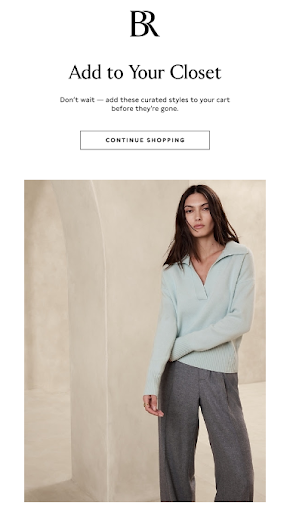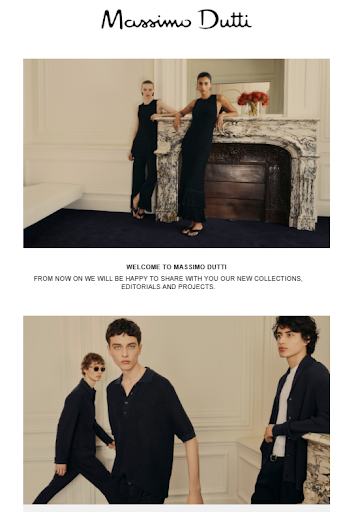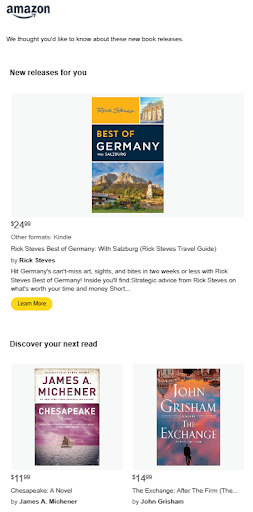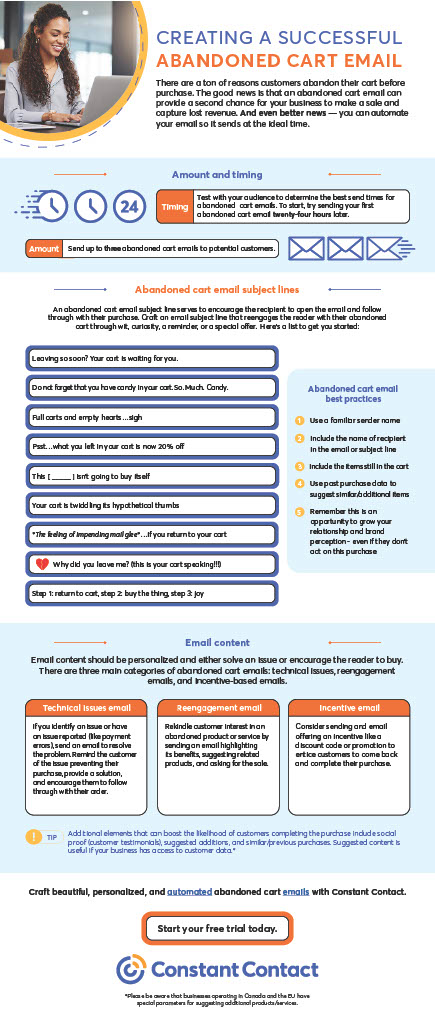
Think back to the last time you met someone new. Maybe it was a friend, a coworker, or a soon-to-be partner. Your initial conversation was probably generic; perhaps you introduced yourself and discussed shared interests like football or job duties. Over time, as you got to know each other better, the conversation began to flow naturally, and now you’d feel lost without them.
The same relationship development process occurs in business-to-business (B2B) and business-to-consumer (B2C) marketing. When a new customer visits, you know nothing about them. As a marketer, your job is to develop the relationship and turn them into a regular client. One of the best ways to do so is through email nurturing.
What is email nurturing?
Email nurturing involves using emails to connect with clients, understand their needs, and develop relationships. Through a carefully cultivated email nurture campaign, you can increase conversions and sales, driving up your revenues and building a solid customer base.
That sounds like every marketer’s goal, but how does it work in practice?
What is an example of nurturing?
Let’s take an example. Assume you own an e-commerce website selling children’s clothing. You sell various jackets, sweaters, shirts, pants, and socks for newborns to middle-schoolers. A new visitor signs up for your promotional emails, and you start communicating with them. Your first email is a confirmation message thanking them for subscribing. A few days later, you ask them to update their profile details, which you use for targeted promotions. The new client has a two-year-old boy, so you begin sending segmented emails for boy toddler clothing. Three emails go out with no response, but the client jumps on a 10% discount coupon in your fourth email. You’ve just nurtured your client into a sale.
What are the benefits of email nurturing?
Nurture email campaigns benefit companies seeking to build a solid customer base that returns to them repeatedly. Email is inexpensive, unlike other advertising methods, such as commercials or print advertisements. Once you get a client’s email address, you can frequently promote your business and reach customers directly.
Emails can also increase conversion opportunities. The more you learn about your client through their interaction with your emails, the better you can target future campaigns for their specific needs. When they see you have what they want, they’re more likely to buy rather than turn to a competitor.
Planning your email nurturing campaign
Any marketing campaign starts with planning — and email nurturing is no different.
Setting clear objectives for your campaign
To make the most of your lead-nurturing emails, start by identifying your objectives. What do you want from the customer? While a sale is ideal, you can build your way up. Maybe you’d like to establish your authority in your industry or encourage them to sign up for a free trial. Perhaps you have gated content (like a free ebook) they can download, or you want them to schedule a call with your sales team.
Starting with smaller goals helps you build a relationship slowly without jumping straight into sales tactics. It tells the client, “Hey. Thanks for your interest. Here’s what I can offer you, and I want our relationship to be mutually beneficial.”
Identifying target audiences and segmentation strategies
Once you set a few goals, you can begin segmenting your subscriber list and targeting clients based on different factors, including demographics, interactions with your company, and their current stage in the customer journey.
Understanding the email nurturing campaign sequence
You’ll want to establish an email lead nurturing campaign sequence for each segmented group and goal. The email nurture sequence should follow the natural cadence of the relationship. For instance, you wouldn’t send a welcome email to someone who has placed multiple orders with your company. Instead, you might notify them about a current sale or ask them to update their profile for any new interests they have.
Creating content that resonates with your audience
Key to any successful email nurture campaign is your messaging. Pay close attention to your tone and content, ensuring they align with your company’s voice while resonating with your audience. Since most people are short on time and won’t read a lengthy email, keep messages concise unless you have a specific reason for a longer email.
Utilizing templates and automation software
Familiarize yourself with the features of your email marketing software. Most providers (like Constant Contact) include customizable templates for inspiration. Templates can be huge time-savers, freeing you up for more complex tasks. Some software also provides automation, allowing you to establish specific nurture email sequences with little hands-on interaction needed.
Executing your email nurturing strategy
Keep these email nurture campaign best practices in mind to get off to a running start.
1. Personalize communication for greater impact
Customers like to feel they’re more than just a number to your business. Show them you care by personalizing their emails to their interests. For instance, this Banana Republic email uses prior browsing history to encourage the buyer to finish their purchase. Since the recipient is already familiar with the items, they’re more likely to take action.

2. Test and optimize emails for best performance
Photos and content encourage the reader to take action on an email — but it’s never easy to know which photo will increase click-throughs or what message will resonate with clients. That’s where A/B testing is crucial. Try sending similar messages with slightly different wording and images and review the results. If you see a particular email gets drastically better results than the other, that’s your winner.
3. Don’t ignore timing and frequency
Some customers appreciate daily emails from their favorite brands, while others prefer less frequent contact. Ask your customers how often they’d like to receive communications from you and stick within the given limits. If they don’t provide their preference, don’t spam them — instead, contact them once a week. That way, you avoid flooding their inbox.
4. Pay attention to email compliance laws
Certain jurisdictions have privacy and spam laws you must abide by. Make sure you understand the laws regarding marketing emails, and always get approval from customers before including them in your email nurturing campaign.
Resources:
US: CAN-Spam
Canada: CASL
EU: GDPR
Lead nurturing email examples and content ideas
What type of content should you use to nurture your email subscribers? Try a few of these ideas.
Welcome new customers and introduce your brand
Anytime someone new subscribes to your mailing list, it gives you an opportunity to welcome them to your company. Give a high-level overview of what they can expect from your future emails, and include any contact info — such as social media profiles — they can follow if they like. Here’s an example of a new customer email from Massimo Dutti:

Entertain and educate with relevant content
Providing your subscribers with valuable, informative content shows them you’re an expert in your field. If you’re a service provider, regularly sharing industry news and relevant tips demonstrates your knowledge. They’ll know to come to you when they need your help. This is especially important for companies in the B2B sector that offer services to other companies. Some companies with great B2B lead nurturing email examples include Slack and Cision.
Offer discounts to encourage sales
Discounts and coupons encourage subscribers on the fence about purchasing to take the plunge. You can tailor your offers specifically to items they browse or provide a general discount they can use on anything in your business.
Recommend related products or services
If a client recently purchased an item from you, use the opportunity to push complementary items they might need. Amazon does this well — it frequently sends new recommendations based on your purchasing history. Here’s an example of an Amazon recommendation email:

Celebrate customer milestones and anniversaries
Capturing important client dates and milestones — such as their birthday, anniversary, or one-year relationship with your company — tells them you care. Try scheduling automated celebratory emails that show you care. You might include a gift or one-time discount to use that month.
Announce new products and services
Do you have a major new product or service announcement? Don’t be shy — make sure your subscribers know! Send a message and include all the info — pictures, features, pricing, and availability.
Engage with surveys and feedback requests
Any time a client interacts with your company, email them about their experience. Keeping a pulse on your clients helps you identify things they love about your organization and where you can improve.
Reengage customers with abandoned cart reminders
Abandoned carts can be frustrating; your client liked the product enough to start the purchase process, but something stopped them from completing it. Sending an abandoned cart email the next day encourages them to move forward.

Email nurturing challenges and solutions
It’s common to encounter a few challenges with email nurturing.
Dealing with low engagement rates
Low engagement rates can be distressing. You put effort into writing and designing your email; you want every subscriber to read it! Get proactive if your open rates and click-throughs are lower than expected. Try A/B testing to see if different templates or messaging are more effective. You can also examine your segmentation strategy to target subscribers interested in specific content.
Overcoming email fatigue in recipients
You notice your open rates are higher when a customer initially subscribes but declines over time. That’s a symptom of email fatigue. Your client may feel overwhelmed by your emails, especially if you send them frequently. Try asking directly for feedback — they might still want to hear from you, but less often or only about specific topics.
Addressing email deliverability issues
It’s crucial to regularly scrub your subscriber list and remove email addresses with deliverability issues. If your email doesn’t go through more than once, the client isn’t receiving it, and continuing to send emails may result in a penalty to your domain. Penalties can increase the risk of email service providers sending your emails to spam — something you certainly don’t want.
Leveraging technology for email nurturing
Technology moves at warp speed, making creating professional emails and perfecting your marketing strategy much more manageable. Here are a few tools that can help:
Email marketing automation and integration with CRM systems
A CRM system allows you to manage client details in one spot. It can help you establish automated email sequences based on client preferences and buying history.
Using email tracking software to gain insights
Monitoring the results of your email campaigns is critical. You want to know if your strategy is working. Constant Contact’s email marketing platform has a comprehensive tracking system with lots of helpful metrics.
The role of AI and machine learning in enhancing email campaigns
Advanced technologies, like AI marketing tools, can assist you with much of the grunt work associated with email marketing. You can use it to streamline your targeting strategy, generate subject lines, or create custom images.
Email campaign analytics and adjustments
Keeping a close eye on your analytics tells you how receptive your subscribers are to your campaign. Common metrics marketers use include:
- Click-through rate: Tells you whether clients clicked on links provided in your emails
- Open rate: The percentage of subscribers who open your email
- Conversion rate: Percentage of readers that followed through on a call-to-action
- Bounce rate: Percentage of undelivered emails from your campaign
As you solidify your email marketing strategy, consider setting a few metric benchmarks to meet. Continuously monitor your KPIs, and if you fall short, try A/B testing to see if minor adjustments improve your results.
Considerations in email nurturing
There are a few considerations to keep in mind as you navigate your email nurturing journey.
The impact of mobile-friendly emails
Most consumers own a smartphone — and chances are high that a vast percentage of your subscribers use them to check their emails. Ensuring your emails are mobile friendly is crucial. Otherwise, smartphone viewers won’t be able to easily view it, and your campaign results will suffer.
Ensuring cybersecurity in email communications
Cybersecurity is another vital factor. Protect your subscribers’ personal information, inform them of privacy measures, and never buy or sell marketing data to third parties.
Adhering to email etiquette for professionalism
Finally, keep it professional! Always run your emails through a spelling and grammar checker before hitting the send button, and respond to client requests promptly.
Advanced email nurturing tactics
Once you feel confident with your email nurturing strategy, you can move on to more advanced techniques.
Multi-channel lead nurturing for comprehensive coverage
Multi-channel lead nurturing involves using different platforms, like social media, email, print marketing, and advertisements, to connect with clients. Encourage them to follow your social media accounts and sign up for direct mail to maximize your promotion efforts.
Retargeting and remarketing via email
You can use your subscriber’s emails to retarget them through various platforms, including Facebook, Instagram, and Google Ads. Retargeting allows you to reach them directly through personalized ads. For instance, you might show a retargeted ad for an item they recently browsed on your website.
Creating dynamic content for enhanced personalization
Dynamic content strategies allow you to customize what your clients see on your website, ads, or dynamic emails according to their interests or browsing behavior. Dynamic content can help you improve engagement and, ultimately, conversions.
Take the next steps with email nurturing
Strengthening customer relationships through email nurturing takes time — but it’s well worth your while. Through your campaign, you’ll learn more about your clients, allowing you to tailor your strategy to meet their interests. Email marketing is constantly changing, so stay on top of new trends and adapt when necessary. That way, you stay ahead of the curve and keep your clients where you want them: with your brand! To learn more about email marketing strategy, check out Constant Contact’s guide to how to create the perfect email or our email newsletter templates for inspiration.




